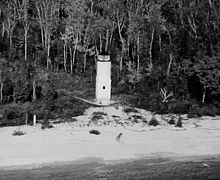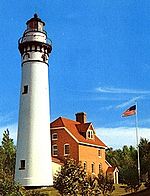Plum Island Range Lights
 Rear range light with house | |
 | |
| Location | Plum Island, Wisconsin |
|---|---|
| Coordinates | 45°18′28″N 86°57′29″W / 45.30778°N 86.95806°W[1] Rear range light |
| Tower | |
| Constructed | 1896 |
| Foundation | Concrete |
| Construction | Iron |
| Automated | c. 1969 |
| Height | 65 feet (20 m)[2] |
| Shape | Skeletal |
| Markings | KRW |
| Light | |
| First lit | 1897 |
| Focal height | 80 feet (24 m) |
| Lens | Fourth order Fresnel lens, still in place |
| Range | 14 nautical miles (26 km; 16 mi) |
| Characteristic | Fixed Red |
The Plum Island Range Lights are a pair of range lights located on Plum Island in Door County, Wisconsin. They were part of the Plum Island United States Life-Saving Station. Plum Island was transferred to the United States Fish and Wildlife Service in 2007 and became part of the Green Bay National Wildlife Refuge. The life-saving station was listed on the National Register of Historic Places in 2010. Plum Island is closed to the public to protect ground nesting migratory birds.
History

Plum Island is an island at the western shore of Lake Michigan in the southern part of the town of Washington in Door County, Wisconsin, United States. There have been hundreds of shipwrecks off the island's shores.[5]
The front and rear range lights were part of the United States Life-Saving Station that was established on Plum Island in 1896.[6] The lights were originally lit in 1897 and are 1,650 feet (500 m) apart, aligned on a 330° bearing line to guide boats safely into the Porte des Morts Passage. The Plum Island front range light was originally identical to the front range light of the Baileys Harbor Range Lights, but was replaced by a modern skeletal light in 1964. The rear range light is the original tower and was added to the National Register of Historic Places in 1984, as the Plum Island Range Rear Light, reference number #84003659. The front light is directional, aligned on 330.5° true. The rear light is omnidirectional and still has its original 4th order Fresnel lens.[7]
Nearby Pilot Island and Plum Island were two of four Wisconsin properties turned over by the U.S. Coast Guard to the United States Bureau of Land Management. Large expenses for toxic waste-site environmental remediation were an impediment to transfers and restoration of the Plum Island site.[8] Both islands were finally transferred to the United States Fish and Wildlife Service in 2007 and became part of the Green Bay National Wildlife Refuge.[9] Significant numbers of nesting colonial birds are found on the islands.[10]

The lighthouse keeper's house and Coast Guard station were listed as being among Wisconsin's ten most endangered historic properties in April 2000.[8][11][12] All of the maritime structures on Plum Island were listed on the National Register of Historic Places in 2010.[13] The Friends of Plum and Pilot Islands, Inc. have partnered with the United States Fish and Wildlife Service to restore the life-saving station on Plum Island.[9] They accomplished lead paint abatement and repainting of the historic boathouse in the summer of 2010.[13]
Getting there

The United States Fish and Wildlife Service closed Plum Island to public access to "ensure necessary protection of ground nesting migratory birds."[14] The life-saving station can be seen at a distance from the Northport-Washington Island ferry.
References
- ^ Light List, Volume VII, Great Lakes (PDF). Light List. United States Coast Guard. 2014.
- ^ Pepper, Terry (May 21, 2004). "Plum Island Range Lights". Terry Pepper. Retrieved March 23, 2011.
- ^ "Amateur Radio Lighthouse Society, Plum Island Rear Range (Lake Michigan) Light ARLHS USA-608".
- ^ "National Register Information System". National Register of Historic Places. National Park Service. March 13, 2009.
- ^ University of Wisconsin Sea Grant. "Wisconsin's Great Lakes Shipwrecks: Death's Door". Wisconsin: University of Wisconsin Sea Grant Institute. Retrieved March 23, 2011.
- ^ Foss, Matt (n.d.). "Saving the U.S. Life-Saving Station on Plum Island" (PDF). Friends of Plum and Pilot Islands, Inc. p. 2. Retrieved March 23, 2011.
- ^ United States Coast Guard (USCG) (2009-08-06). "Classical Lenses in Operation" (PDF). USCG. Archived from the original (PDF) on March 25, 2009. Retrieved March 23, 2011.
{{cite web}}: Unknown parameter|deadurl=ignored (|url-status=suggested) (help) - ^ a b D'Entremont, Jeremy, Islands at Death's Door (October, 2003) Lighthouse Digest.
- ^ a b Foss, Matt (n.d.). "Saving the U.S. Life-Saving Station on Plum Island" (PDF). Friends of Plum and Pilot Islands, Inc. p. 30. Retrieved March 23, 2011.
- ^ United States Fish and Wildlife Service (USFWS) (May 16, 2008). "Lighting the Way for the Future of Plum and Pilot Islands". USFWS. Retrieved March 23, 2011.
- ^ Rowlett, Russ. "Lighthouses of the United States: Eastern Wisconsin". The Lighthouse Directory. University of North Carolina at Chapel Hill.
- ^ Wobser, David, Plum Island Range Lights at boatnerd.com.
- ^ a b United States Fish and Wildlife Service (USFWS) (October 31, 2010). "Green Bay National Wildlife Refuge Historic Boathouse Receives a New Coat of Paint". USFWS. Retrieved March 23, 2011.
- ^ United States Fish and Wildlife Service (USFWS). "Green Bay National Wildlife Refuge". USFWS. Retrieved March 23, 2011.
Further reading
- Eckert, Jack A. Life on Pilot Island in 1955.
- Havighurst, Walter (1943) The Long Ships Passing: The Story of the Great Lakes, Macmillan Publishers.
- Oleszewski, Wes, Great Lakes Lighthouses, American and Canadian: A Comprehensive Directory/Guide to Great Lakes Lighthouses, (Gwinn, Michigan: Avery Color Studios, Inc., 1998) ISBN 0-932212-98-0.
- Pepper, Terry, Seeing the Light, Plum Island Range lights.
- Robb, David, Recollections of Plum Island at Seeing the Light.
- Sapulski, Wayne S., (2001) Lighthouses of Lake Michigan: Past and Present (Fowlerville: Wilderness Adventure Books) ISBN 0-923568-47-6; ISBN 978-0-923568-47-4.
- Wright, Larry and Wright, Patricia, Great Lakes Lighthouses Encyclopedia (Erin: Boston Mills Press, 2006) ISBN 1-55046-399-3.
External links
- Friends of Plum and Pilot Islands
- NPS Inventory of Historic Light Stations - Wisconsin
- Plum Island Range Lights at Door County Maritime Museum
- Cleanup Completed at Wisconsin's Plum Island
- "Historic Light Station Information and Photography: Wisconsin". United States Coast Guard Historian's Office. Archived from the original on 2017-05-01.

